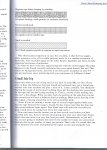famous beagle
Well-known member
First off, I prefer working with analog, just so everyone knows on which side of the fence I am. However, I'm confused about something, so I thought someone here may be able to clear it up.
Ok ... so ... from what I understand, magnetic tape basically (and I stress basically) works like this:
The tape is coated with metallic oxide particles.
A high-frequency signal (bias) energizes these particles (basically) and aids them in overcoming intertia
The incoming analog signal is converted to an electric one, which charges the oxide particles and arranges them in an order, which forms an "analogue" of the sound wave.
Upon playback, this analogue is then read by the playback head and sent to the speakers, where it's converted back to an analog signal.
Is that the gist?
Assuming it is---and please feel free to correct any major errors if I made them---here's my question:
Analogue is often referred to as "continuous" recording, whereas digital is "sampled." But ... there has to be a finite amount of oxide particles on the tape, right? So ... there can only be so many available to form the "analogue" of the sound.
So ... in a sense, isn't analogue recording essentially sampling the sound as well? I mean, I have no idea how many oxide particles are used to represent the signal at any given time (or space on the tape), but it's finite. And the less oxide you have on the tape, the less complete the signal would be, right? (Similar to a lower digital sampling rate)
Am I right in thinking this? Or am I way off?
Thanks for any input!
Ok ... so ... from what I understand, magnetic tape basically (and I stress basically) works like this:
The tape is coated with metallic oxide particles.
A high-frequency signal (bias) energizes these particles (basically) and aids them in overcoming intertia
The incoming analog signal is converted to an electric one, which charges the oxide particles and arranges them in an order, which forms an "analogue" of the sound wave.
Upon playback, this analogue is then read by the playback head and sent to the speakers, where it's converted back to an analog signal.
Is that the gist?
Assuming it is---and please feel free to correct any major errors if I made them---here's my question:
Analogue is often referred to as "continuous" recording, whereas digital is "sampled." But ... there has to be a finite amount of oxide particles on the tape, right? So ... there can only be so many available to form the "analogue" of the sound.
So ... in a sense, isn't analogue recording essentially sampling the sound as well? I mean, I have no idea how many oxide particles are used to represent the signal at any given time (or space on the tape), but it's finite. And the less oxide you have on the tape, the less complete the signal would be, right? (Similar to a lower digital sampling rate)
Am I right in thinking this? Or am I way off?
Thanks for any input!






